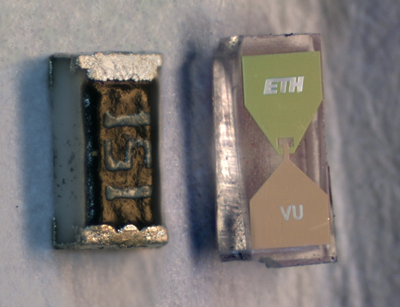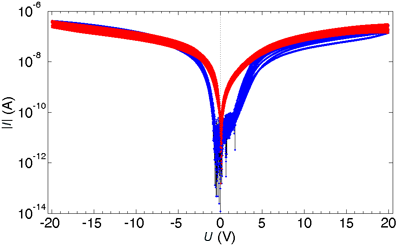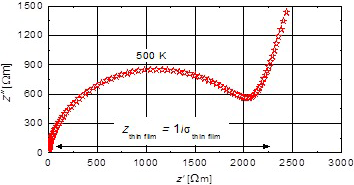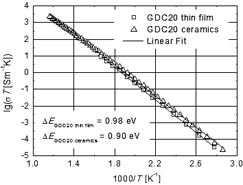|
|||||||||||
!!! This document is stored in the ETH Web archive and is no longer maintained !!!
Broadband High Temperature Impedance Spectroscopy
Spark Award 2014

(video, 10.03.2014)
Patent: Strained Multilayer Resistive-switching Memory Elements
News
- December 2016: Yanuo Shi has defended his PhD. Congratulations!
- November 2016: We are excited that Sebastian Schweiger has successfully defended his PhD thesis. Congratulations Sebastian, you earned it!
- November 2016: Congratulations to Maximilian Jansen, who was awarded the ZENO KARL SCHINDLER Foundation Master Thesis Grant to carry out research for his Master Thesis in the group of Prof. Bilge Yildiz at MIT.
- October 2016: Congratulations to Felix Messerschmitt for successfully defending his PhD thesis.
- October 2016: Prof. Jennifer Rupp has been interviewed by NZZ am Sonntag, Der Standard, Le Matin and several other news outlets to give her expertise regarding the latest news on exploding Li-Ion batteries.
- September 2016: Farewell to Dr. Iñigo Garbayo, who is moving to the Catalonia Institute for Energy Research (IREC) in Barcelona, Spain. The team of Electrochemical Materials wishes you all the best for your future, Iñigo!
- August 2016: A recent publication on solid state Li batteries by Jan van den Broek, Semih Afyon and Jennifer L.M. Rupp has been featured on ETH News.
- July 2016: Congratulations to Rafael Schmitt, Roman Korobko and Jonathan Spring for receiving the poster award at ISSFIT-12 in Kaunas, Lithuania, 2016.
- June 2016: New master thesis or student project available: Novel Perovskite Solid Solutions for Solar-Thermochemical Fuel Production
- June 2016: We are excited to welcome our new Postdoc Sören Boyn to the team of Electrochemical Materials!
- May 2016: Jan van den Broek was awarded the second prize at the Zuger Wissenschaftspreis for his Master Thesis "All-solid-state Li-ion Batteries Based on Garnet-type Fast Li-ion Conductor LLZO". Congratulations, Jan!
- May 2016: Congratulations to Rafael Schmitt for receiving the European Materials Research Society (E-MRS) Young Scientist Award at the 2016 E-MRS Spring Meeting in Lille, France.
- May 2016: Congratulations to Alexander Bork for receiving two travel awards: the 2016 Chemistry Travel Award by the Swiss Academy of Science (SCNAT), the Swiss Chemical Society (SCS) and the Swiss Society for Food Chemistry (SSFC) and a travel grant from the Knud Højgaard Fond.
- April 2016: The team of Electrochemical Materials says farewell to Dr. Semih Afyon, who will leave the group to start his own group as Assistant Professor at the Izmir Institute of Technology in Turkey. Congratulations and all the best for your future, Semih!
- March 2016: New master thesis available: "Uncovering Magnetic-Field Coupled Resistive Switching in Ferrimagnetic Insulators for Novel Devices".
- February 2016: Philipp Simons, a new PhD student started at Electrochemical Materials.
- February 2016: Electrochemical Materials keeps growing. Today two new postdocs, Alfonso Carrillo and Andreas Nenning started. Within the Lithuanian-Swiss we are also happy to have Prof. Tomas Salkus and Vilma Venckute as guests in our group.
- January 2016: New master thesis available: "Engineering a novel resistive switching device-type based on a functional bilayer oxide unit".
- January 2016: The Hans-Eggenberger Prize 2015 for Interdisciplinary Electronic
Engineering was awarded to Reto Pfenninger for his work on
strained memristor micro-dot fabrication. Congratulations to Reto being the
first Swiss material scientist to receive this prestigeous award. - November 2015: We are very happy to announce that our proposal for a joint Lithuanian-Swiss Programme on "Broadband impedance study of memristor oxide" films got accepted.
- October 2015: A new paper by Markus Kubicek was published. "Uncovering Two Competing Switching Mechanisms for Epitaxial and Ultrathin Strontium" Titanate-Based Resistive Switching Bits
Media Coverage:
Swiss National Science Foundation
Business24.ch
IEEE Spectrum
New Electronics - September 2015: We are very delighted to have our Raman Microscope sucessfully installed. We are looking forward to work with this great new tool.
- August 2015: Congratulations to Dr. Semih Afyon for his new paper: "A Shortcut to Garnet-type Fast Li-Ion Conductors for All Solid State Batteries".
Media Coverage:
Green Car Congress - July 2015: Two new papers are available online: One from the
Memristive Information Storage and Logics group: "How does Moisture affect the Physical Property of Memristance for Anionic-Electronic Resistive Switching Memories?" and also the first publication of the Solar-to-Fuel Conversion Reactor Materials team: "Perovskite La0.6Sr0.4Cr1-xCoxO3-δ Solid Solutions for Solar-Thermochemical Fuel Production: Strategies to Lower the Operation Temperature".
- June 2015: The "Memristive Information Storage and Logics"-Team is featured in SRF's Einstein's TV report on new memory technologies.
- June 2015: Congratulations to the PhDs Yanuo Shi, Alexander Bork and Sebastian
Schweiger to their Nature Materials article and July cover: "The effect of mechanical twisting on oxygen ionic transport in solid-state energy conversion membranes". Their article was also selected as cover for the June issues of Nature Materials.
Media coverage:
ETH News Article - April 2015: We are very excited to welcome Eva Sediva as a new PhD student joining the Memristive Information Storage and Logics team.
- March 2015: Prof. Jennifer Rupp was reelected as a member of the European Academy of Science. Congratulations!
- February 2015: CNN's "Make Discover Innovate" features Electrochemical Material's Memristive Information Storage and Logics research!
- January 2015: Dr. Semih Afyon's latest paper on new High Capacity Cathode Materials for Rechargeable Li-ion Batteries also got media coverage on 20 Minuten and Blick am Abend.
- November 2014: Dr. Roman Korobko from Weizmann Institue of Science started at Electrochemical Materials.
- November 2014: Prof. Rupp, Electrochemical Materials, receives the
career SNSF Starting (ERC) Grant for the project "Beyond von-Neuman computing –
Materials Functionalization and Integration of Threedimensionally stacked
Multiterminal Memristive Oxides Replacing Existing Transistors for Neuromorphic
Computing".
press coverage - November 2014: Two book chapters by Prof. Jennifer Rupp were published. "Elektrochemische Materialforschung für die Energiewende" in "Energie im Wandel" and "Solid Oxide Fuel Cells: Introduction" in the Encyclopedia of Applied Electrochemistry.
- October 2014: Welcome to Dr. Inigo Garbayo from Spain who joins our group as a PostDoc.
- September 2014: Prof. Jennifer Rupp gives a talk at the WEF Annual Meeting of the New Champions
in Tianjin, China titled "Discover! New Material Science" on the change
of the energy landscape and also on memristor information storage and
logic materials and devices. Furthermore, she also participated in several panel discussions. ETH Globe article - September 2014: Prof. Rupp accepted the nomination and mandat by the Swiss
Federal Department of Environment, Transport, Energy and Communication to serve
as a member on the new Swiss Energy Technology-fund board on invitation by
Federal Councillor Doris Leuthard starting in 2015. - August 2014: Prof. Jennifer Rupp was selected as one of the top 40 international scientists under the age of 40 to speak at the World Economic Forum (WEF) in China on new innovative Materials and Devices for Global Energy Challenges.
- August 2014: New paper featured as VIP (top 5%) at Advanced
Functional Materials on connecting memristor kinetics from materials to device
performance. "Memristor Kinetics and Diffusion Characteristics for Mixed
Anionic-Electronic SrTiO3-δ: The
Memristor-based Cottrell Analysis Connecting Material to Device
Performance". - August 2014: Dr. Semih Afyon joined the team of Electrochemical Materials.
- Congratulations to Sebastian Schweiger and Felix Messerschmitt, both won
a "2014 SCNAT/SCS Chemistry Travel Award" for PhDs by the Swiss
Academy of Sciences.
- July 2014: We are happy that Reto Pfenninger continues as a PhD student in our group after sucessfully finishing his master thesis.
- May 2014: Dr. Michal Struzik started at Electrochemical Materials.
- Apr. 2014: New paper out in ACS Nano on strain-engineering and new microfabrication routes to capture real strain effects. "A Microdot Multilayer Oxide Device: Let Us Tune the
Strain-Ionic Transport Interaction"
- Mar. 2014: The
team of Electrochemical Materials receives the Spark Award 2014 by ETH
Zurich. The prize stands for the most innovative and economically
important Invention of the
year 2014 and was selected for a patent among 170 inventions at ETH. The
price was award for their invention of a new memtistive memory storage
concept based on strain-defect oxide engineering. In particular, the
PhDs Sebastian Schweiger and Felix Messerschmitt
are congratulated for their success!
- Mar. 2014: The
Electrochemical Materials Team receives the Alstom Energy Seed Fund
for their new project "All Ceramic Li+ Batteries with high Thermal
Operation Window".
- Feb. 2014: New students joined ECM.
- Jan. 2014: New paper in Advanced Functional Materials: Scalable Oxygen-Ion Transport Kinetics in Metal-Oxide Films: Impact of Thermally Induced Lattice Compaction in Acceptor Doped Ceria Films
- Two new students started in our group, Jessica Genta and Reto Pfenninger.
- We cordially welcome Rafael Schmitt, Alexander Bork and Sha Li in our group.
- Today two new members joined our Team. Welcome to Dr. Rahul Fotedar and Dr. Markus Kubicek.
- The second Kepler workshop (with strong participation of Prof. Jennifer L.M. Rupp) was announced.
- New Master Project: Joint master project at IBM Research Zurich & Electrochemical Materials ETH about Metallic Oxides
- Electrochemical Materials has launched a collaboration with eZelleron GmbH.
- Announcement: Prof. Rupp will give her introductory lecture on April 22nd 2013.
- Welcome to our new PhD student Yanuo Shi and our new intern Gustav Schiefler
- New Master Project: Construction and Testing of a Test-Rig for Micro-Solid Oxide Fuel Cell Arrays with Integrated Reformer
- Prof. Jennifer Rupp was awarded with the Kepler Prize 2012.
- Welcome
to our new PhDs Sebastian Schweiger and Felix Messerschmitt
- August, 1st 2012
Start of the Electrochemical Materials group
Inaugural Lecture

Prof. Jennifer Rupp: Nano-Elektronik und -Ionik: Memristive Speicher und Energie Konversion (video, 08.02.2013)
Electrochemical Materials is collaborating with Vilnius University in a Swiss-Lithuanian collaboration project under the title "Broadband High Temperature Impedance Spectroscopy".
The project is devoted to the production of oxide thin films by PLD method and their detailed analysis by impedance spectroscopy. The project will be implemented by four secondments of Lithuanian researchers to Switzerland, where they, under supervision of Swiss partners, will produce strontium titanate and gadolinium doped ceria thin films and prepare the electrodes for electrical characterization. The impedance spectroscopy measurements will be performed in Lithuania with the modified broadband impedance spectrometer at high frequencies up to 10 GHz.
The films can find a potential application in the new generation memory elements, the so called memristors. The understanding of physical reasons for memristor element switching is the main aim of the project. Besides, the training of Vilnius University group researchers to work with PLD system and film characterization in Switzerland will be beneficial for Lithuanian scientists. The final discussion of the results will be in Vilnius during the common scientific seminar at the end of the project.
Achievements
Strontium titanate (STO) and ceria gadolinia (CGO) thin films were grown by PLD method in Switzerland. Platinum electrodes of a special geometry were formed by using photolithography. The films with the applied electrodes behave as memristors.

Further on the electrical properties were investigated. The film response to the triangular-shape voltage change in time shows memristive behaviour, hence their I-V curves have a hysteresis.

The impedance spectroscopy investigation at high frequencies on oxygen solid electrolyte films was performed for the first time. A semicircle was observed in the complex plane plot of impedance, and it is related to oxygen ion relaxation process in the film.
Temperature dependences of CGO film conductivity was deduced from impedance spectra. Arrhenius graph (logarithm of conductivity vs. inverse temperature) shows similar conductivity values compared to the bulk conductivity of ceramics with the same chemical composition.


Conclusions
1. Lithuanian scientists learned the technological conditions of STO and CGO thin film growth by PLD.
2. Individual STO and CGO thin film samples have been produced, and they were suitable for high frequency impedance spectroscopy investigation.
3. Cyclic voltammetry results on STO and GDC thin films with crossbar electrode configuration showed memristor behaviour.
4. High frequency impedance spectrometer has been modified, allowing usage of DC bias when measuring impedance.
5. Relaxation type electrical parameter dispersion was observed in CGO thin film impedance spectra. The conductivity of CGO film was nearly identical to the conductivity of ceramics bulk.



Project Start: 1 January 2016
Project End: 30 September 2016
Project acronym: BISMOF
Project Agreement Number: CH-3-ŠMM-02/06.
Budget: 151 229 EUR 24 cnt.
Wichtiger Hinweis:
Diese Website wird in älteren Versionen von Netscape ohne
graphische Elemente dargestellt. Die Funktionalität der
Website ist aber trotzdem gewährleistet. Wenn Sie diese
Website regelmässig benutzen, empfehlen wir Ihnen, auf
Ihrem Computer einen aktuellen Browser zu installieren. Weitere
Informationen finden Sie auf
folgender
Seite.
Important Note:
The content in this site is accessible to any browser or
Internet device, however, some graphics will display correctly
only in the newer versions of Netscape. To get the most out of
our site we suggest you upgrade to a newer browser.
More
information

